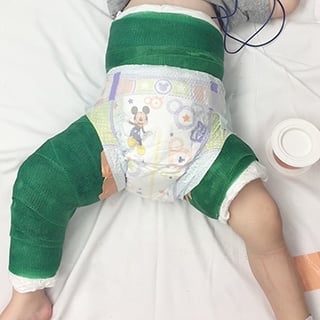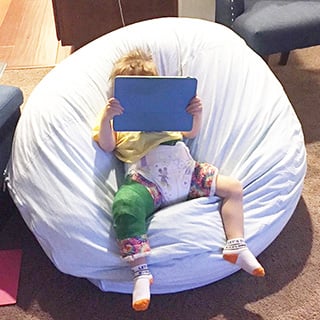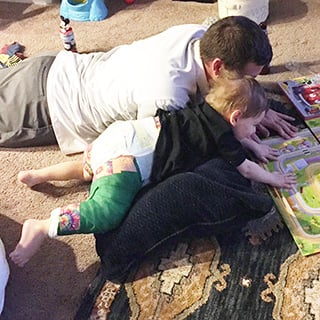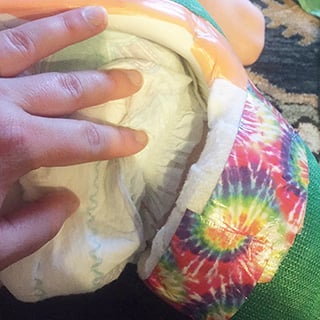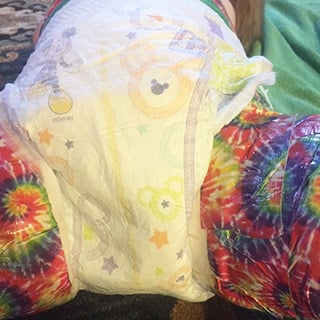Spica (body) casts are used in babies and children to allow healing by keeping the thigh bone (femur) and pelvis in position. They may be placed for a fractured femur (thigh bone), after hip or pelvis surgery, or after tendon surgery around the hip. A spica cast covers the child from armpit-level around the chest all the way to the ankle of one or both legs. If the cast goes only to one ankle, the other leg is in the cast to just above the knee. There is an opening in the diaper area. The inside layer is made of Gore-Tex – which is waterproof and breathable – to minimize the risk of moisture inside the cast. The outer layers are made of cotton and fiberglass or plaster.
Spica casts are almost always placed with the child under sedation or anesthesia (completely asleep). The length of time your child will be in the cast is determined by the doctor, the condition being treated and your child's healing process. We typically will not change the cast because we want to minimize your child's exposure to anesthesia. If your surgeon recommends a cast change, this is done in the operating room and will require sedation or anesthesia. It is important to care for your child's spica cast properly.
The following tips will make caring for your child easier while they're in the cast.
Cast care
- Keep the cast clean and dry. A wet cast can damage your child's skin. Never try to dry the cast with a warming device (such a blow-dryer), as this may cause burns.
- Do not put anything down (inside) the cast. This can cause a sore or an infection. Protect the cast with a towel or large bib from small toys, dirt and pieces of food. If something gets into the cast and you can see it, try to remove it with your hand. If you can't see or reach the object, call your child's doctor.
- If your child complains of itching, use a blow-dryer set on cool to blow air down into the cast or suggest that they try scratching another part of the body.
- Your child's cast has a Gore-Tex lining that helps protect and waterproof the interior, especially around the groin area. There are special ways to double diaper in order to prevent wetness from accidents. Your child's nurse can show you how to do this.
- Don't allow your child to pull any padding out of the cast. The padding protects their skin from rubbing and sores.
- If you notice the edges of the cast becoming rough or sharp, or if the tape or moleskin strips start to roll up or become soiled, contact the orthopedic nurse or cast technician about a cast adjustment.
Skin care
- Don't use lotions, oils or powders on the skin under the cast.
- Check the skin daily for sore areas. Use a flashlight to look inside the cast. If your child had hip surgery, be sure to check the incision in the groin area.
- If you notice a rash, cleanse the skin with mild soap and a damp washcloth and allow the area to air-dry. Call the orthopedic nurse if you think it's getting worse or you see bleeding.
- Change your child's position at least every two hours. (Your child's care team will give instructions for what to do while your child sleeps.) Lying in one position in the heavy cast can cause skin sores.
- A bean bag chair can make position changes easier and enhance comfort – plus, your child may find it fun!
- You can also use pillows and blanket rolls for positioning support. Put a pillow or blanket roll under the lower leg – not under the heel – to keep the heels off the ground.
- Place your child on their belly a few times during the day to give their rear end a rest. If they're uncomfortable on their belly, try putting them on the bean bag chair or use a few folded blankets or pillows lengthwise under the chest and abdomen to lift them off the ground slightly.
Diet
- Your child may prefer to eat small frequent meals instead of three larger meals a day.
- To prevent constipation, your child needs to drink a lot of fluids and eat high-fiber foods. Good sources of fiber are apples, pears, oatmeal, whole-grain cereals and beans. If you're concerned that your child is constipated, speak to their orthopedic care or primary care provider.
- Be careful with small pieces of food: Your child can't sit up straight in the cast, which makes it easier to choke. A bean bag chair can be used to position them upright when eating.
Going to the bathroom
- While we want to keep the cast as clean as possible, accidents do happen. If your child has an accident, wash their skin well and air out the diaper area for as long as possible. If the cast has urine on the inside, you can use wipes or a damp cloth to try to clean the soiled areas. Don't panic: Most casts get urine or stool on them at some point during the casting treatment.
- If your child was in the early stages of potty training, you may find it challenging to revert to diapering. Remind yourself that when the cast comes off, your child can restart potty training.
If your child wears diapers
- The best option is a method called double diapering. First, use a smaller size diaper than usual and rip off the tabs (they can scratch the skin). Next, tuck the diaper up under the edges of the cast. The diaper should cover the child's entire bottom. This keeps urine and stool inside the diaper and keeps the cast from getting damp and dirty. Next, use a larger diaper over the cast. (Depending on your child's size, you may need to use an adult diaper.) This helps keep the smaller diaper in place. Make sure the elastic band on the bigger diaper by the groin is not on the cast; it should be on the smaller diaper.
- Check the diapers often, and change them at least once during the night to avoid soiling the cast.
If your child is potty trained
- Depending on the position of the cast, your child may be able to sit on the toilet. If not, it is OK to revert to using diapers or try using a bedpan.
- Boys can use the urinal provided by the hospital.
- Girls can try using a paper cup with a small hole in the bottom to direct urine into the toilet.
- It may help to use plastic wrap to protect the cast when potty-trained children are using the bathroom.
If the cast gets wet
- Don't stress out – accidents happen.
- If the cast gets soaked, it will take a long time to dry. You can speed the process up by using a blow-dryer on the cool setting or taking your child out into the sun.
- Your child's own body heat will also help dry the cast.
- Reposition your child periodically so that different areas can dry out. The back of the cast is the most common area to get wet.
- If you are worried about the wet cast or notice any edges softening due to the wetness, call your child's orthopedic care provider.
Bathing and hair washing
- Your child will need sponge baths. Make sure their skin is completely dry after washing. You can use the blow-dryer on cool to help dry the skin and air out the cast.
- If odor becomes a problem, you can sprinkle a small amount of deodorant body powder on the cast or spray a small amount of underarm deodorant on the cast. Never apply household cleaners, deodorizers or disinfectants, such as Lysol.
- It often works well to use the sink for washing your child's hair. If you have enough counter space, you can lay your child on the kitchen counter with their head over the sink. Be sure to cover the cast with a towel and wring out their hair before they sit up or the water will run down into the back of the cast.
Clothing
- Clothes should be loose and comfortable. Light clothing may be all your child needs. Often a loose-fitting shirt and socks are enough.
- T-shirts should be one or two sizes larger than usual to fit over the cast.
- Most children in a spica cast don't wear pants or shorts.
- Shorts or sweatpants in a larger size may fit over the cast. You can apply or sew in Velcro strips to allow older children to wear their clothing and underwear.
- The cast can make the child warmer than usual. Avoid heavy blankets. Sweating can irritate the skin.
Safety concerns, traveling and other activities
- A child in a spica cast should never be left alone. Children may have difficulty rolling over or moving in the cast. Someone should be watching them at all times.
- Check your child's toes daily. They should be warm and pink. When you press on the toenail, it will turn white. When you let go, it should turn pink in two to three seconds. If it takes longer, your child's cast may be too tight and you should elevate their legs for 15 minutes. Your child should be able to move their toes.
- Your child must always wear a seat belt while in a stroller, wheelchair or car. If your child needs a wheelchair, the orthopedic team will order one for you.
- Don't allow your child to walk in a spica cast. This can disrupt the healing process.
- Some children don't fit safely in their car seat while in a spica cast. Speak with your child's nurse to discuss options, such as purchasing a wider car seat with lower sides. You can also rent a car seat from our trauma services department.
- If your child expresses pain, give pain medicine as directed by their doctor. They may need pain medicine for a few weeks.
- Your child should not stand on the injured leg, but older children may be able to stand on the opposite leg to make getting out of bed or onto a chair easier. A physical therapist can show you how to do this.
- Toward the end of their time in the cast, some children learn to crawl, roll or scoot where they want to go.
- After the cast is removed, children often return to their normal activities gradually. If your child was already walking before getting the cast, their provider will explain when it's safe for them to resume walking, running and jumping. After the cast is removed, they may have a limp until their strength returns.
Safely transporting a child in a spica cast
If your child's surgery is scheduled in advance, you'll have time to take care of transportation concerns beforehand. The surgeon can likely tell you the approximate size of the cast, its width, and how much it will bend at the knees. Depending on the abduction of your child's legs (how far they are from the body's midline), your child may not fit properly in their car seat. The orthopedic team can help you figure out a good solution.
A child in a spica cast may fit in a conventional convertible car seat with lower sides and a wider front, particularly one that will recline in both rear-facing and forward-facing positions. This will depend on your child's weight, height and age.
Here are a few car seat options:
- Radian 80 can partially recline in both forward-facing and rear-facing positions, and it has low sides (though it is narrow).
- Britax Marathon, Roundabout and Boulevard have wide seats with low sides.
- Combi offers car seats with forward-facing reclining positions.
- A Britax Frontier 85 booster seat may fit an older child.
- Sometimes a small baby may fit into a car bed (available through the hospital loaner program), depending on how their cast is made.
What if my child doesn't fit in their car seat?
If your child will be in a spica cast following orthopedic surgery and needs a car seat, you may arrange to pick one up from the trauma services office at (510) 428-3045. Please set this up as soon as you know the date of your child's surgery. The department attempts to keep a variety of car seats in stock but can't guarantee having the right size on hand.
Pickup procedure
To borrow a car seat, you'll need to come to the trauma services office and sign the financial responsibility agreement. You will be given guidance on installing the seat correctly and resources to have it checked as properly installed in your vehicle.
Return procedure
At the time of your child's orthopedic follow-up appointment, you'll return the seat to the trauma services office (or bring it to the emergency department if trauma services is closed). It's not an option to leave the car seat in the orthopedic department.
Child passenger restraints for children in spica casts
Another option for children in spica casts is a product called the modified EZ-ON vest. This vest is for children ages 2 to 12 and weighing from 20 to 100 pounds. The 101M2 is better for children who are 5 to 12 years old and between 65 and 100 pounds. The M203-XS provides a snugger fit for children 2 to 5 years of age, 20 to 65 pounds. When using an EZ-ON vest, your child must travel lying down in the back seat. Visit their website to find a distributor in your area.
Help your child have fun while in a spica cast
- Take your child outside. For smaller children, you can use a soft-sided wagon, a toddler tricycle with push handle, or a stroller that reclines. Bigger children may need a wheelchair with a reclining back.
- Ask friends and relatives to visit.
- Read a favorite book.
- Do arts and crafts. You can decorate the cast with Sharpie markers (no glitter or glue).
- Custom-made spica tables, which support kids as they play, are available on Etsy or from certain parent groups, though not all children tolerate the positioning.
- Play board, word, computer or video games. Put puzzles together.
Returning to school or day care
- Children usually can't go to school or day care in a spica cast due to the amount of close care they need. After the cast is removed, it may be a few weeks to months before your child returns to "normal activity." Talk to your child's orthopedic care provider about when your child can safely return to school or day care.
- Check with your employer or the state disability office to see whether you qualify for paid family leave or to take unpaid time off work under the Family and Medical Leave Act. If you qualify, our office can assist you with completing the paperwork.
When to call the doctor
Reach out to your child's care team if any of the following occur:
- Your child has severe pain and the prescribed pain medication doesn't help.
- You see a change in the cast, such as cracking, softening or drainage from the inside.
- You notice an unpleasant odor coming from the cast.
- Your child's toes are cool, blue, gray or swollen.
- Your child feels numbness or tingling in their toes.
- Your child can't move their toes.
- You see redness, swelling or drainage coming from an incision.
- The position of the cast changes, or the cast looks like it may be slipping off. Your child develops a fever (temperature over 101.5) with no other signs of illness (such as cold symptoms or an earache).
- You have any questions or concerns.
Contact us
If you have a question or concern about your child, please call us:
- On weekdays between 8 a.m. and 4:30 p.m., call (510) 428-3238 and ask to speak with your surgeon's nurse.
- After 4:30 on weekdays or anytime on weekends and holidays, call (510) 428-3000 (the main hospital number) and ask to speak with the on-call orthopedic resident.





























